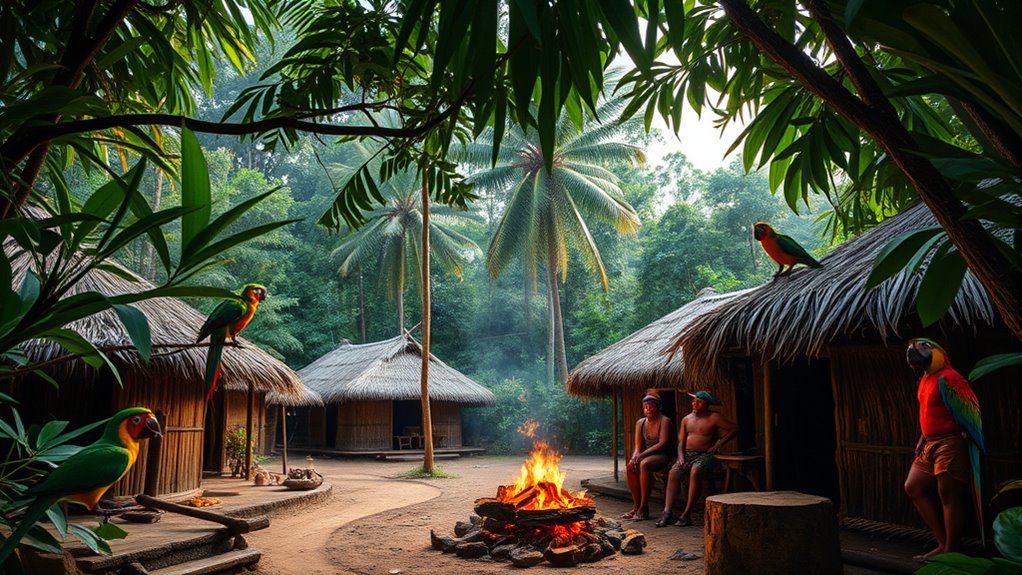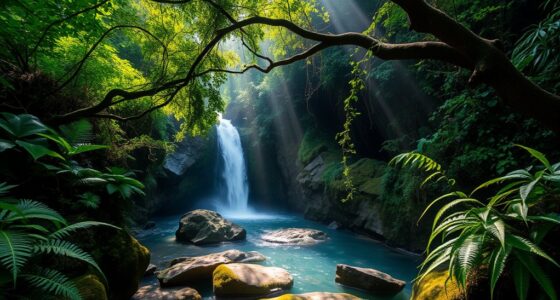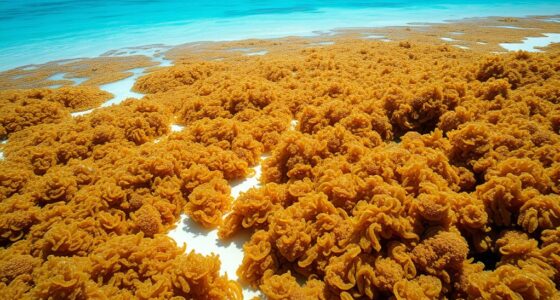Jamaica’s Maroon communities have fought for freedom for over 300 years, resisting colonial oppression through fierce military tactics, strategic alliances, and unwavering cultural preservation. They kept their traditions alive, which boosted morale and reinforced their identity. Their leadership and ingenuity made it difficult for colonial powers to reconquer their territories. Their legacy of resilience, independence, and clever diplomacy continues to inspire. Exploring this story reveals how their fierce spirit shaped Jamaica’s history and future.
Key Takeaways
- Jamaica’s Maroon communities maintained their independence through resilient cultural practices like dances, songs, and rituals.
- They formed strategic alliances and negotiated treaties, such as the 1739 Treaty of Cudjoe’s Town, to secure autonomy.
- Skilled leadership and military tactics enabled them to defend their territories for centuries.
- Cultural resilience fostered community unity, resistance, and preserved their identity against colonial oppression.
- Their legacy symbolizes enduring resistance, sovereignty, and inspiration in the fight for freedom.

Have you ever wondered how Jamaica’s Maroon communities managed to resist slavery and maintain their independence? The answer lies in their remarkable cultural resilience and strategic historical alliances. From the early 18th century, these communities refused to be subdued by colonial authorities, forging a powerful identity rooted in their traditions, language, and unwavering spirit. Their ability to preserve their cultural practices amidst oppression became an essential source of strength, allowing them to mobilize and fight back effectively. You can see this resilience in their dances, songs, and rituals—elements that not only kept their history alive but also boosted morale during times of hardship. Their cultural resilience became more than just preservation; it became a form of resistance, a way to sustain their community’s unity and defiance against slavery’s brutality.
Alongside cultural resilience, the Maroons built pivotal historical alliances that helped secure their freedom and autonomy. Recognizing the power of alliances, they negotiated with colonial powers, sometimes even forming temporary truces, to strengthen their position. These alliances were often rooted in mutual interest—permitting them to defend their territories and resist further encroachment. The Maroons also allied with other marginalized groups and exploited divisions within colonial society, turning these relationships into strategic advantages. Over time, they established fortified settlements and military strategies that made it difficult for colonial authorities to reconquer their lands. Their leadership, often embodied by skilled warriors and tacticians, fostered a sense of collective purpose. These alliances, combined with their fierce independence, allowed them to maintain control over their territories for centuries. Additionally, their military strategies showcased their ingenuity and adaptability in warfare, further cementing their reputation as formidable opponents.
What makes their story even more compelling is how they blended their cultural resilience with diplomatic skills. They used their traditions as a unifying force, rallying their people and intimidating potential enemies. Meanwhile, their diplomatic efforts helped negotiate treaties that recognized their autonomy, such as the famous 1739 Treaty of Cudjoe’s Town. These agreements granted them certain rights and recognition, even as colonial powers tried to suppress their independence. The Maroons understood that survival depended not only on fighting but also on smart negotiation and building lasting alliances. Their ability to adapt and leverage their cultural strength and alliances kept them resilient through generations, turning their communities into symbols of resistance and sovereignty. Today, their legacy continues to inspire and remind us of the power of cultural resilience and strategic partnerships in the fight for freedom.
Frequently Asked Questions
How Do Maroon Communities Maintain Their Cultural Identity Today?
You can see how maroon communities keep their cultural identity alive today by practicing traditional crafts and passing down oral histories. They actively preserve unique customs, language, and stories through community events and storytelling sessions. By engaging in these practices, you help maintain their heritage, ensuring that their history of resistance and freedom remains vibrant and relevant for future generations.
What Are the Current Economic Activities of Jamaica’S Maroons?
You see that Jamaica’s Maroons engage in various economic activities today. They actively promote Maroon craft, creating unique art and handmade items that reflect their culture. You’ll also find Maroon tourism thriving, as visitors come to experience their rich history, traditional music, and dances. These activities help sustain their communities while preserving their heritage, allowing them to thrive economically while honoring their legacy.
How Do Maroons Interact With the Jamaican Government?
You see, Maroons actively engage with the Jamaican government through negotiations to maintain their sovereignty and protect their community rights. They assert their independence by negotiating treaties that recognize their autonomy, while also collaborating on issues like land rights and cultural preservation. These government negotiations help guarantee Maroon sovereignty remains respected, allowing them to preserve their traditions and self-governance while working within the broader national framework.
Are Maroon Traditions Still Practiced in Daily Life?
You might think Maroon traditions have faded, but they’re alive in daily life. You see it in traditional dances that connect generations and herbal medicine used for healing, passed down through centuries. Even with modern influences, Maroons keep their culture vibrant. These practices aren’t just history—they’re active, living parts of their identity that continue to shape their community today.
What Challenges Do Maroon Communities Face in Modern Jamaica?
You face several challenges today, like securing land rights as outsiders’ influence grows. Modern development pressures threaten your community’s autonomy, making it harder to preserve your traditions and way of life. External interests often encroach on your land, risking displacement. Despite these obstacles, your resilience and cultural pride help you continue practicing your traditions and fighting for recognition and protection in contemporary Jamaica.
Conclusion
Your journey through Jamaica’s Maroon communities shows they’re living proof that freedom isn’t given; it’s fought for. For over 300 years, they’ve kept their independence alive, refusing to be beaten down. Their story reminds you that sometimes you have to stand your ground and fight for what’s yours. Just like them, you learn that perseverance and courage can turn the tide, proving that where there’s a will, there’s a way.










